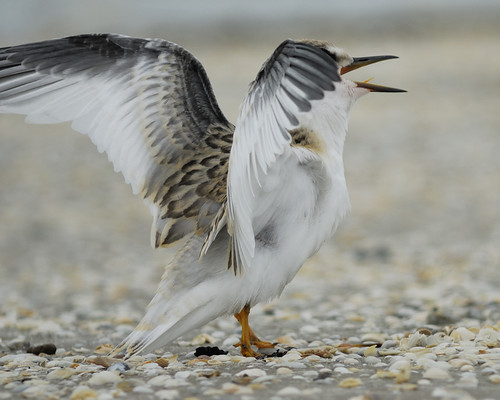tags: Least Tern, Sterna antillarum, birds, mystery bird, bird ID quiz
[Mystery bird] Least Tern, Sterna antillarum, photographed at Bolivar Flats Shorebird Sanctuary, Houston, Texas. [I will identify this bird for you in 48 hours]
Image: Joseph Kennedy, 24 July 2009 [larger view].
Nikon D200, Kowa 883 telescope with TSN-PZ camera eyepiece 1/750s f/8.0 at 1000.0mm iso400.
Please name at least one field mark that supports your identification.
- Log in to post comments
More like this
tags: Yellow-crowned Night-heron, Nycticorax violaceus, birds, mystery bird, bird ID quiz
[Mystery bird] Yellow-crowned Night-heron, Nycticorax violaceus, photographed at Bolivar Flats, Texas. [I will identify this bird for you in 48 hours]
Image: Joseph Kennedy, 24 July 2009 [larger view].…
tags: birds, mystery bird, bird ID quiz
[Mystery bird #1] Ring-necked Duck, Aythya collaris, photographed at the Hermann Park Conservancy, Houston, Texas. [I will identify this bird for you in 48 hours]
Image: Joseph Kennedy, 18 November 2009 [larger view].
Nikon D200, Kowa 883 telescope with…
tags: Roseate Spoonbill, Platalea (Ajaia) ajaj, birds, mystery bird, bird ID quiz
[Mystery bird] Roseate Spoonbill, Platalea (Ajaia) ajaj, photographed at Arthur Storey Park, Houston, Texas. [I will identify these birds for you in 48 hours]
Image: Joseph Kennedy, 5 December 2009 [larger view].…
tags: Cooper's Hawk, Chicken Hawk, Blue Darter, Accipiter cooperii, birds, mystery bird, bird ID quiz
[Mystery bird] Sharp-shinned Hawk, Accipiter striatus, Cooper's Hawk, also known as a Chicken Hawk or Blue Darter (?!), Accipiter cooperii, photographed at Smith Point, Texas. [I will identify…


Hmmm, Looks like a juvenile Tern begging for food. I think the only terns in range are Royal, Caspian, Forster's, Gull-billed and Least. Royal, Caspian and Gull-billed have either all yellow, orange or black bills. So it's either Laest or Forster's. The dark shoulder bar indicates that it should be Least Tern (Sterna antillarum). That's my guess.
Think you got it again Adrian, an immature/juvenile Least Tern, Sternula antillarum, but note the taxonomic change from genus Sterna to Sternula on the basis of genetic data that correspond to plumage patterns*: yellow legs and a more grayish plumage above differentaites it from the Forster's and Common Terns (orange legs, cinnamon above) and the Roseate (blacklegs, darker margins to the gray above, black cap)
As far as subspecies is concerned, because of it's location near Houston, TX, this is the nominate S. a. antillarum found along the US Atlantic coast from Maine, south along the east and Gulf coasts of the US, Bermuda, the Caribbean
*Bridge, E. S., A. W. Jones, and A. J. Baker. 2005. A phylogenetic framework for the terns (Sternini) inferred from mtDNA sequences: implications for taxonomy and plumage evolution. Molecular Phylogenetics and Evolution 35:459-469.
Hello David, I'll really have to keep up with AOU taxonomy, we Brits seem to be way behind with this.
BTW I must spell-check...I must spell-check.
Adrian, a quick check for me is the AOU Checklist for North American Birds, but if you saw my comments on the Crested Tern (Thalasseus bergii) of November 15th, you'll note I referred to the same research which found that mitochondrial DNA studies confirmed that the three main head patterns shown by terns (no black cap, black cap, black cap with a white forehead) corresponded to distinct clades...
p.s. not worried in the laest about spelling, especially when I can't differentiate between differentiate and differentaite!
Hello David, I didn't even notice yours. At laest yours was the harder word!
That's OK Adrian, at first I thought perhaps a Belgian-born Man Utd reserves defender was also an ornithologist!